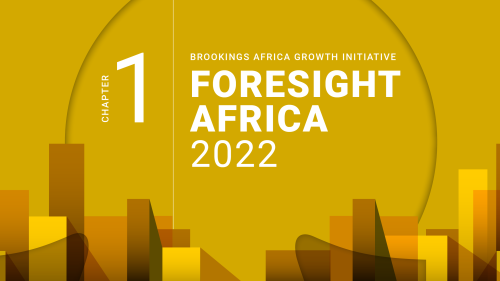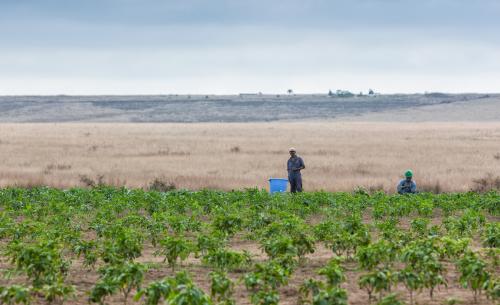Abundant energy resources in many parts of Africa position the continent as a potential location for the production and export of climate-friendly hydrogen, based either on renewable electricity (green hydrogen) or natural gas in combination with carbon capture and storage technologies (blue hydrogen). Green hydrogen is produced via electrolysis by splitting water molecules into their component parts using renewable electricity, while blue hydrogen is produced by splitting natural gas into hydrogen and CO2—after which the CO2 needs to be captured and stored.
Several African countries, especially around the Northern and Southern Tropics, have excellent solar and wind resources. Africa also has large untapped hydropower potential, mainly located along the Congo and Nile Rivers. Countries like Nigeria, Algeria, and Angola have some of the largest gas reserves in the world. Blue hydrogen has been suggested as a low-carbon option for these countries as they seek to diversify their fossil fuel-dependent economies.
This large resource potential has spurred political engagement by a number of European countries, most notably Germany. The German government has partnered with several African countries to develop a Hydrogen Potential Atlas and has committed $45.7 million to the National Green Hydrogen Development Strategy of Namibia. Germany and the Democratic Republic of the Congo have taken up discussions that could see the country relaunch the controversial Inga Dam III project. Germany has also set up so-called Hydrogen Offices in Angola and Nigeria to facilitate dialogue with these fossil fuel-exporting economies.
The politics and economics of hydrogen in Africa
But how realistic are these ambitions, given a number of factors complicating the region’s pursuit of this energy carrier?
First, hydrogen development cannot be separated from Africa’s broader energy landscape. More than half of the African population lacks access to electricity. Per capita consumption of energy in sub-Saharan Africa (excluding South Africa) stands at 180 kWh, compared to 13,000 kWh per capita in the U.S. and 6,500 kWh in Europe. Renewables also remain at an early stage of development: In 2018, the continent generated approximately 180 TWh of renewable power—approximately 20 percent of electricity generation and less than 0.02 percent of its estimated potential.

 Source: IRENA (2014) Estimating the Renewable Energy Potential in Africa; FAO (2011) Water for agriculture and energy: The challenges of climate change; IEA (2019) Africa Energy Outlook.
Source: IRENA (2014) Estimating the Renewable Energy Potential in Africa; FAO (2011) Water for agriculture and energy: The challenges of climate change; IEA (2019) Africa Energy Outlook.
Despite the large potential, capacity additions for the production of green hydrogen raise the question of whether they are coming at the expense of expanding local access to renewable energy to meet socioeconomic needs, to enable clean industrial development, and to meet domestic climate targets within the context of the Paris Agreement. Furthermore, the production of green hydrogen comes with a significant demand for water at a time of increasing levels of water scarcity across Africa—especially in the northern and the Sahel regions. Similarly, the prospect of blue hydrogen as a climate-friendly energy carrier remains highly uncertain, due to residual greenhouse gas emissions, the need for safe CO2 storage sites, and controversy related to the viability of carbon capture and storage technologies.
Moreover, policymakers must consider the economic feasibility of hydrogen exports. Notably, the production of clean hydrogen in some of the most promising locations in Africa could be very cost-competitive, particularly due to abundant availability of solar resources. West Africa alone could produce approximately 120,000 TWh of green hydrogen per year at a price of less than $2.63/kg, assuming no water constraints. However, the cost of transporting hydrogen hampers this competitiveness. Maritime shipping, considered the most cost-effective for distances over 3,000 km, would add an estimated $1 to $2.75/kg. For shorter distances, the cost of pipeline transport could be considerably lower, estimated at $0.18/kg per 1,000 km for new hydrogen pipelines and $0.08 for retrofitted gas pipelines.
Though such infrastructure investments carry high costs and are frequently hampered by delays, current pipelines, when repurposed, could offer a starting point for Africa’s hydrogen trade. Current international pipeline infrastructure in Africa mainly consists of pipelines transporting natural gas from Northern African countries to Europe as well as connections between Egypt and the Middle East. In addition, the West African Gas Pipeline (WAGP) network, which currently transports gas from Nigeria to neighboring countries Benin, Togo, and Ghana, also offers potential for transporting hydrogen. It is the starting point for the recently launched Nigeria-Morocco Pipeline project, which could potentially be further extended to Europe. If constructed as “hydrogen-ready,” the WAGP could be repurposed for the export of hydrogen from West African countries. However, its success will depend on the interests of the Nigerian and Moroccan governments.
Hydrogen development in Africa’s green energy frontrunners
In addition to export-oriented ambitions, African countries are pursuing different, local applications of green hydrogen and related industrial development opportunities. For example, Morocco, a major exporter of fertilizers, plans to replace imports of conventional ammonia with domestic green ammonia, with its first project to start construction in 2022. Similarly, Egypt is investing in a facility for the production of 1 million tons of green ammonia annually.
South Africa has launched a strategy aimed not only at the production of hydrogen but at the domestic manufacturing of hydrogen-related technologies and products. Building on its endowment in platinum-group metals—a key metal for the production of hydrogen technologies, the South African government is promoting an industrial corridor stretching from the Limpopo mining region through Johannesburg’s industrial district to Durban. The country’s chemicals and energy giant, Sasol, has launched an initiative for landmark green hydrogen projects, aimed at greening existing materials and chemical value chains.
Whether ambitions to export large quantities of hydrogen from Africa to Europe will be feasible remains an open question, given the constraints around transport infrastructure, water access, as well as crucial climate-related considerations. Moreover, any strategy to develop hydrogen exports will have to take into account the industrial policy ambitions of important players on the continent or risk losing the goodwill of these key allies.
Note: The authors developed this blog post as part of the Institute for Advanced Sustainability Studies project “Geopolitics of the Energy Transformation: Implications of an International Hydrogen Economy (GET Hydrogen),“ which has been supported with funding from Germany’s Federal Foreign Office. This blog reflects the views of the authors only and does not reflect the views of the Africa Growth Initiative nor the Brookings Institution more broadly.








Commentary
The promise of African clean hydrogen exports: Potentials and pitfalls
May 10, 2022